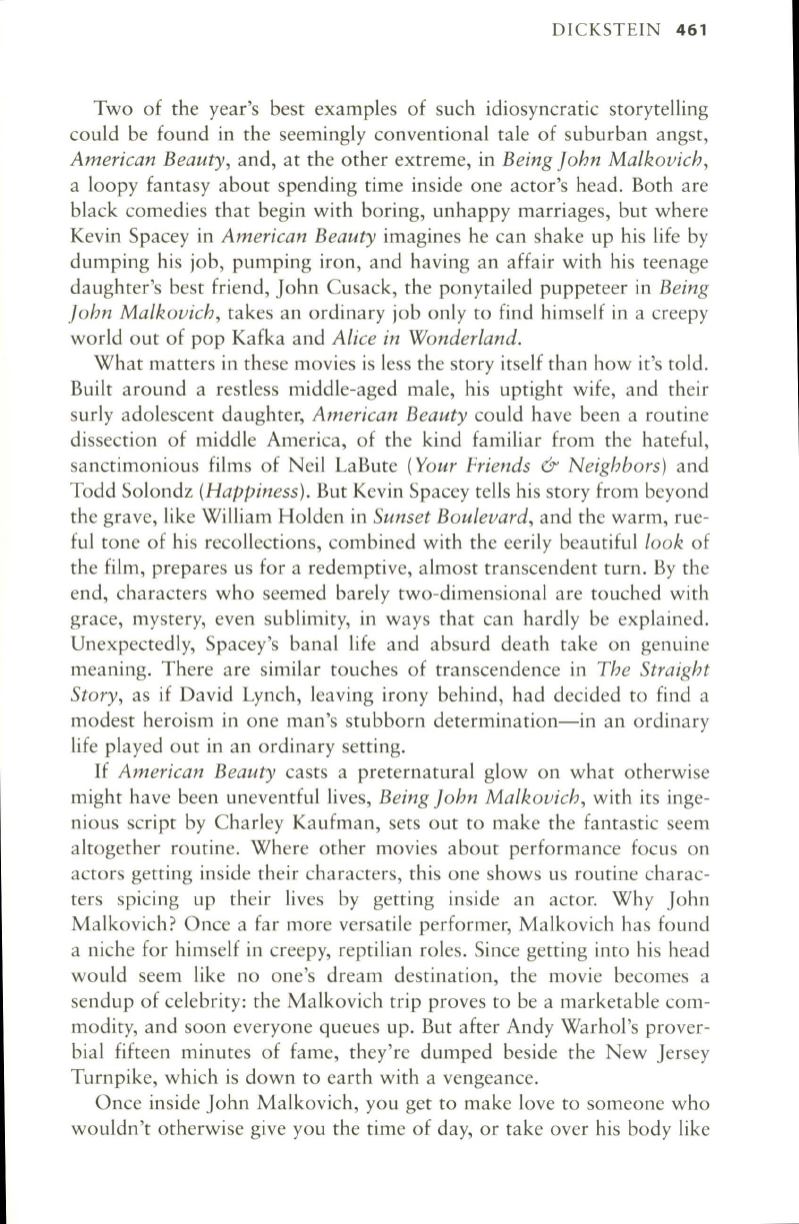
DICKSTEIN
461
Two of the year's best examples of such idiosyncratic storytelling
could be found in the seemingly conventional tale of suburban angst,
American Beauty,
and, at the other extreme, in
Being John Malkovich,
a loopy fantasy about spending time inside one actor's head. Both are
black comedies that begin with boring, unhappy marriages, but where
Kevin Spacey in
American Beauty
imagines he can shake up his life by
dumping his job, pumping iron, and having an affair with his teenage
daughter's best friend, John Cusack, the ponytailed puppeteer in
Being
John Matkovich,
takes an ordinary job only to find himself in a creepy
world out of pop Kafka and
Alice in Wonderland.
What matters in these movies is less the story itself than how it's told.
Built around a restless middle-aged male, his uptight wife, and their
surly adolescent daughter,
American Beauty
could have been a routine
dissection of middle America, of the kind familiar from the hateful,
sanctimonious films of Neil LaBute
(Your Friends
&
Neighbors)
and
Todd Solondz
(Happiness).
But Kevin Spacey tells his story from beyond
the grave, like William Holden in
Sunset Boulevard,
and the warm, rue–
ful tone of his recollections, combined with the eerily beautiful
look
of
the film, prepares us for a redemptive, almost transcendent turn. By the
end, characters who seemed barely two-dimensional are touched with
grace, mystery, even sublimity, in ways that can hardly be explained.
Unexpectedly, Spacey's banal life and absurd death take on genuine
meaning. There are similar touches of transcendence in
The Straight
Story,
as if David Lynch, leaving irony behind, had decided to find a
modest heroism in one man's stubborn determination-in an ordinary
life played out in an ordinary setting.
If
American Beauty
casts a preternatural glow on what otherwise
might have been uneventful lives,
Being John Malkovich,
with its inge–
nious script by Charley Kaufman, sets out to make the fantastic seem
altogether routine. Where other movies about performance focus on
actors getting inside their characters, this one shows us routine charac–
ters spicing up their lives by getting inside an actor. Why John
Malkovich? Once a far more versatile performer, Malkovich has found
a niche for himself in creepy, reptilian roles. Since getting into his head
would seem like no one's dream destination, the movie becomes a
send up of celebrity: the Malkovich trip proves to be a marketable com–
modity, and soon everyone queues up. But after Andy Warhol's prover–
bial fifteen minutes of fame, they're dumped beside the New Jersey
Turnpike, which is down to earth with a vengeance.
Once inside John Malkovich, you get to make love to someone who
wouldn't otherwise give you the time of day, or take over his body like


